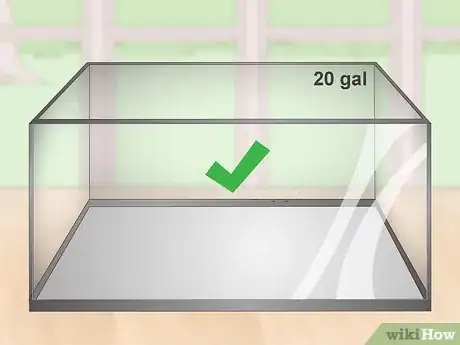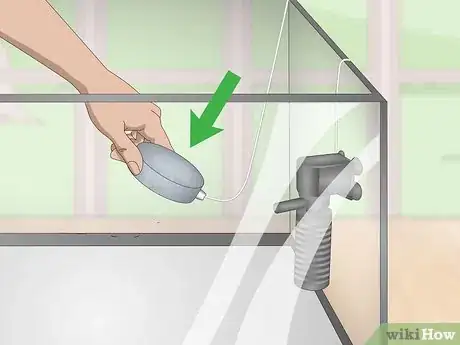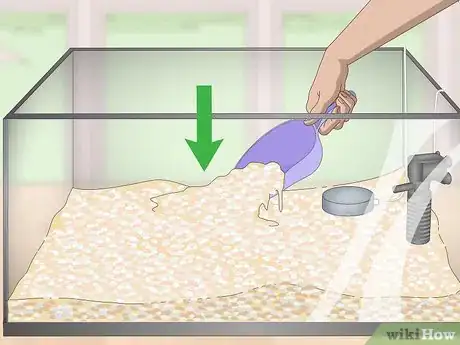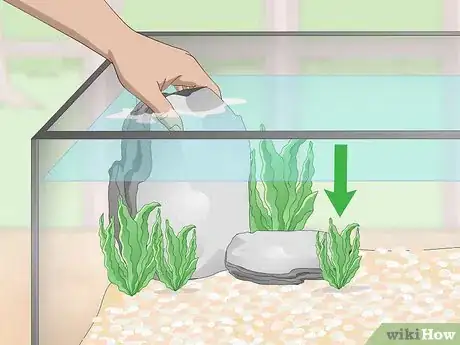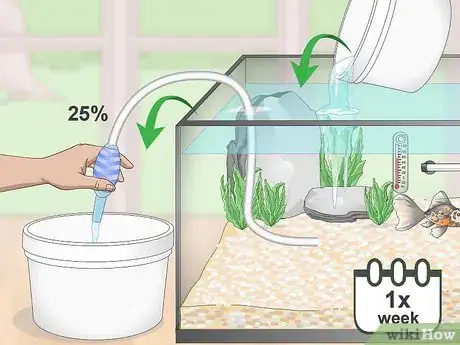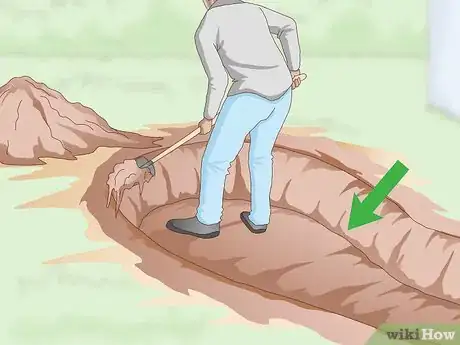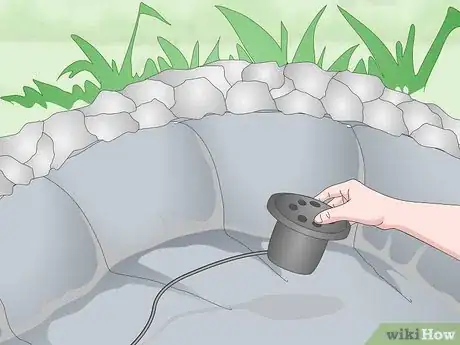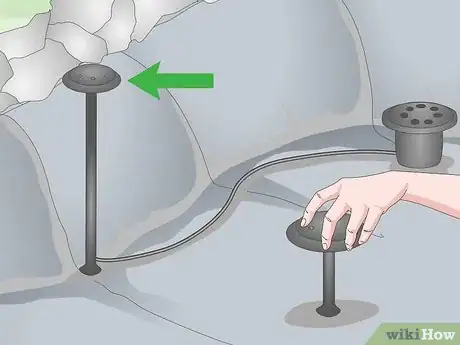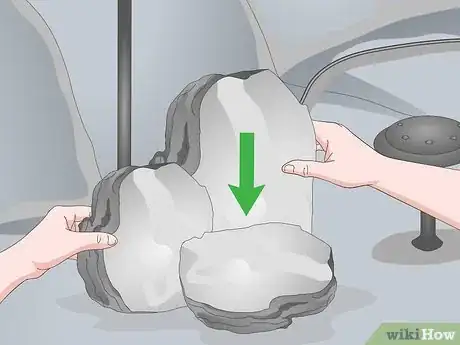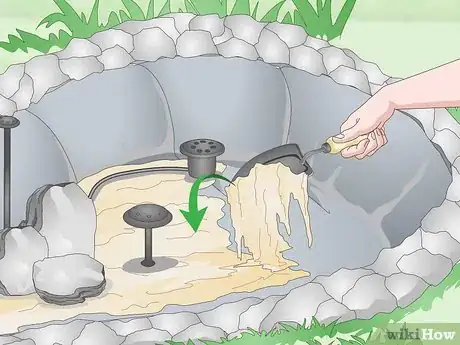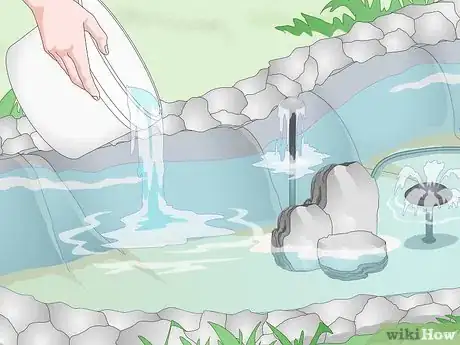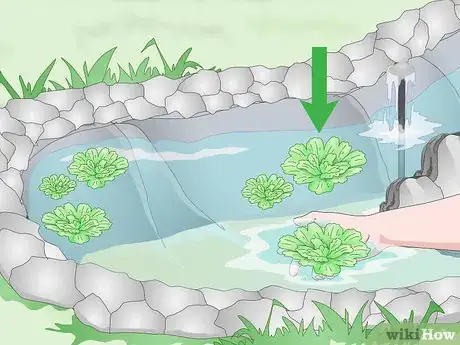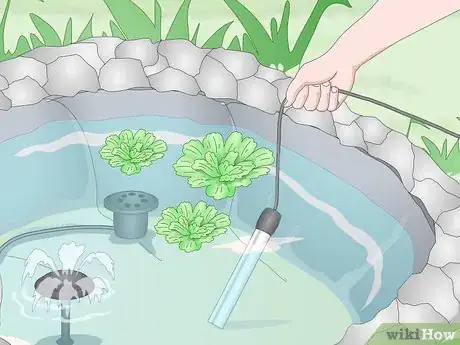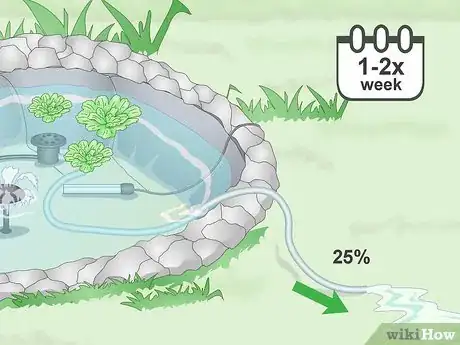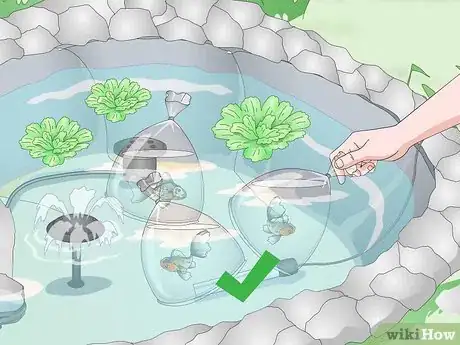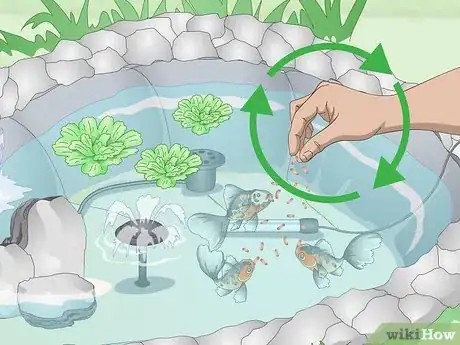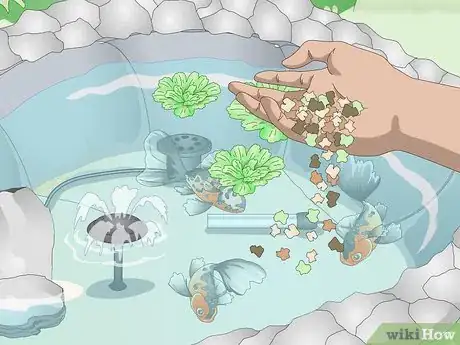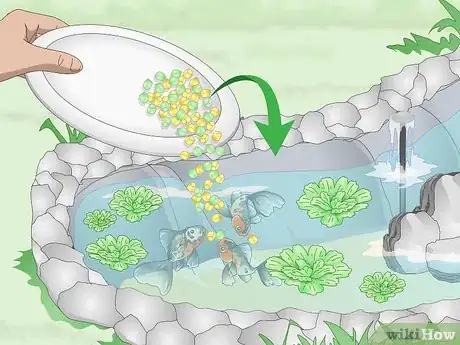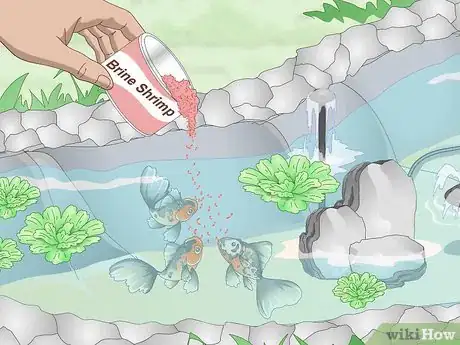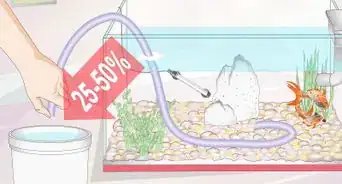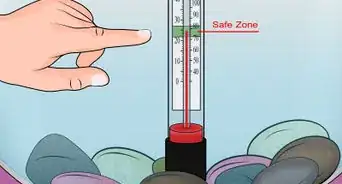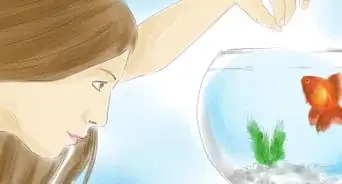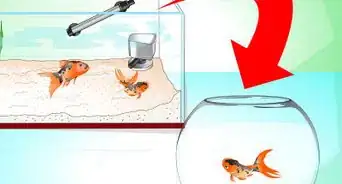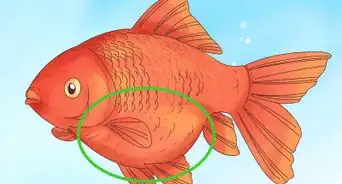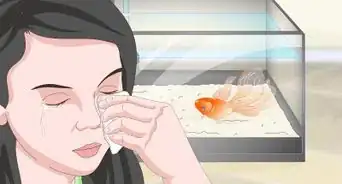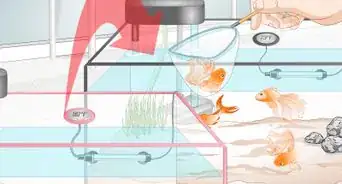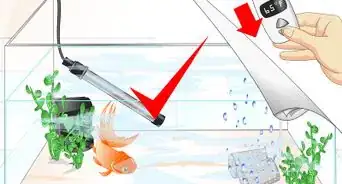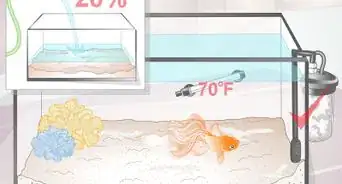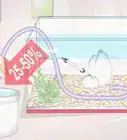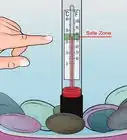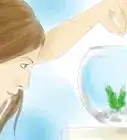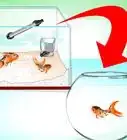This article was co-authored by Doug Ludemann and by wikiHow staff writer, Megaera Lorenz, PhD. Doug Ludemann is the owner and operator of Fish Geeks, LLC, an aquarium services company based in Minneapolis, Minnesota. Doug has worked in the aquarium and fish-care industry for over 20 years, including having worked as a professional aquarist for the Minnesota Zoo and Shedd Aquarium in Chicago. He received his Bachelor of Science in Ecology, Evolution, and Behavior from the University of Minnesota.
There are 14 references cited in this article, which can be found at the bottom of the page.
This article has been viewed 58,231 times.
Shubunkin goldfish are hardy, beautiful fish that can live for many years if you provide them good care. These large fish do well in either aquariums or ponds. Wherever you keep your fish, they will need plenty of space and clean, well-aerated water. Shubunkins have big appetites and need a variety of foods to stay healthy and happy.
Steps
Keeping Shubunkin Goldfish in a Tank
-
1Get a tank that’s at least 20 gallons (76 L). A single shubunkin goldfish can live in a tank that is 15 gallons (57 L) at minimum, but will be happier in a 20–30 gallons (76–114 L) tank. If you want to keep more than one shubunkin, add 10 gallons (38 L) of space per additional fish.[1]
- An adult shubunkin can grow as large as 18 inches (46 cm) in length in a spacious enough environment.
-
2Provide a good filtration and aeration system. Purchase a filter that is appropriate for the size of your tank. The filter should be capable of removing debris and unwanted chemicals from the water.[2] Most filters also provide aeration, but you may wish to get an additional air pump if you have a large tank. Ask a fish specialist at your pet store to recommend the best filter and air pump for your needs.
- Like most goldfish, shubunkins are active fish that need a lot of oxygen and produce a large amount of waste. A good filter and aeration system are vital to the health of your fish.
Advertisement -
3Add a gravel substrate to your tank. Get medium-sized aquarium gravel that is too large for your fish to easily swallow. A gravel floor creates an attractive, natural-looking environment in the tank.[3]
- Waste and debris will quickly build up in the substrate, so clean it at least twice a week with a siphon-powered gravel vacuum.[4]
-
4Decorate your tank with artificial plants and smooth rocks. If you choose to add décor to your tank, pick decorations without sharp edges or points, since these could hurt your fish. Some smooth rocks or pieces of driftwood are good options. Artificial plants also work well.[5]
- You can add fish-safe live plants to the tank if you wish, but be prepared for your fish to nibble and dig up the plants.
-
5Maintain the water temperature between 65–72 °F (18–22 °C). Shubunkins can survive in a wide range of temperatures (between 40–80 °F (4–27 °C)), but do best in cool water.[6] Keep a thermometer in their aquarium and add a heater if necessary to keep the water in a healthy temperature range.
- Sudden, major fluctuations in water temperature can be dangerous to shubunkin goldfish, so make sure to maintain a consistent temperature in the tank.
- If you have multiple shubunkin goldfish in a tank and don’t want them to reproduce, keep their water under 75 °F (24 °C). Cooler temperatures will discourage breeding.[7]
-
6Change out 25% of the water once a week. Every week, use a siphon to remove 1/4 to 1/3 of the water in the tank. Replace the missing water with clean, dechlorinated water. Keeping the water clean is essential to the health of your fish.[8]
- If you like, you can add some snails to the aquarium to reduce algae buildup in the tank.
Equipping and Maintaining a Shubunkin Pond
-
1Build a pond if you don’t already have one. You can either build a pond from scratch or buy a premade form for your pond. Choose a spot in your yard or garden that gets a good balance of sunlight and shade throughout the day and has soil that is not excessively rocky. You’ll also need to choose a spot that is easily accessible for maintenance and convenient for setting up electrical equipment (such as pumps and filters).[9]
-
2Purchase a filtration system designed for a fish pond. Good filtration is as important in a pond as it is in an aquarium. Buy a filter that is suitable for the size of the pond where you will be keeping your shubunkin goldfish.[12]
- You can buy fish pond filtration systems online or at many home and garden supply stores. Check the packaging to find out if the system you’re interested in is suitable for the volume of your pond.
- If you prefer, you can also build your own filter for the pond.
-
3Get at least 1 aeration pump for your pond. Your pond will need an aeration pump to oxygenate the water and prevent stagnation. Look for a pump that is suited to the volume of your pond. For larger ponds, you may need multiple pumps.[13]
- You can purchase pond air pumps online or from home and garden supply stores.
- Adding an airstone or aeration ornament to the tubing from your air pump can soften the current from the pump and help diffuse the air more effectively.
-
4Buy aquarium rocks to decorate the pond. Rocks can add a decorative touch to the pond and give your fish places to hide. Be sure to get rocks and other ornaments that are designed for use in fish tanks or ponds, since other rocks or decorative objects might have contaminants on them that could harm your fish.[14]
- Purchase ornaments and rocks that are free of points or rough edges so that your fish don’t scrape themselves.
- Put large rocks and ornaments in place before adding any substrate to the pond. This way, they will have a more stable surface to rest on.[15]
-
5Cover the bottom of the pond with fish-safe sand. Purchase sand that is marketed for use in fish tanks or ponds, since other sands or gravels could be contaminated with chemicals that might harm your fish. A sand substrate provides natural filtration and gives water plants a place to take root.[16]
- You can buy fish-safe sand online or from a pet supply store.
- Rinse your sand with clean water before adding it to the pond.[17]
-
6Fill your pond with dechlorinated water. Before adding water to the pond, check the water from your hose and make sure it’s not contaminated with chlorine or other chemical additives. You may need to dechlorinate or condition your water before filling the pond.[18]
- You can purchase a water quality testing kit online or from your local pet store.
-
7Put fish-safe plants in your pond. Water plants provide decoration, discourage algae growth in the pond, and can even provide an extra source of nutrition for your fish. Let your pond settle for a few days after adding pumps, filters, and other equipment before you add your plants. Some goldfish-friendly options include:[19]
- Water lettuce
- Duckweed
- Anacharis
- Anubias barteri
- Hornwort
-
8Add a heater if you live in an area where the weather gets cold. While shubunkin goldfish can live in water as cold as 40 °F (4 °C), they will not survive in freezing temperatures or in an environment where the water temperature fluctuates wildly.[20] If you expect cold temperatures in your area, purchase a heater to maintain a healthy temperature range in your pond.[21]
- You can purchase a fishpond heater online or from a pet supply store. Look for a heater designed to work in the size of pond you have.
-
9Change 25% of the pond water once or twice a week. Just like in a tank, it’s important to do partial water changes every 1 or 2 weeks to keep your pond clean and healthy.[22] Use a siphon to remove no more than 25% of the water, then replace the missing water with fresh, dechlorinated water.
- When you change the water, you can also take the opportunity to check your aeration and filtration equipment to make sure it is working properly.
-
10Introduce your fish to the pond gradually. Dumping a whole bunch of shubunkins in your pond can stress or even kill the fish. Add only 1 or 2 fish at a time, and help them transition into their new environment just as you would when adding them to a new tank.[23]
- While there’s no set-in-stone rule for how many goldfish you can keep in a pond, in general it is best to have at least 1 gallon (3.8 L) of space for every 1 inch (2.5 cm) of adult fish.[24]
Feeding Your Shubunkin Goldfish
-
1Give your fish several small meals a day. Shubunkin goldfish have hearty appetites, especially when they live in warmer water. Offer your fish 2-3 small meals throughout the day, but take care not to give them more food than they can handle in a single meal.[25]
- Give your fish only as much food as they can eat within about 2 minutes, or a pinch of food roughly the size of a goldfish’s eye for each fish.[26]
-
2
-
3Supplement their diet with vegetables. Goldfish are omnivores, but plants make up a major part of their diet. Treat your fish to some veggies once or twice a week along with their regular flake or pellet diet. Good vegetable options include skinned peas (cooked), blanched broccoli, zucchini (cut into small cubes), lettuce, or fresh seaweed.[29]
- Since vegetable treats can create a mess in the tank or pond, plan to offer these treats shortly before you do a partial water change or cleaning.
- Feed your goldfish these treats sparingly.[30] For example, you might offer 2 to 3 skinned and halved peas per adult goldfish once or twice a week.
- You can also add live plants—such as duckweed—to your tank or pond as a ready source of vegetable nutrients for your goldfish.
-
4Provide freeze-dried animal foods as treats. In addition to flakes or pellets, you can give your shubunkin goldfish additional protein by offering them foods such as brine shrimp, Daphnia (water fleas), tubifex worms, or blood worms.[31] Try giving your goldfish a pinch of one of these foods a couple times a week as a special treat.
- While your goldfish can eat live foods, these come with a risk of parasites or bacterial contamination.
Community Q&A
Did you know you can get answers researched by wikiHow Staff?
Unlock staff-researched answers by supporting wikiHow
-
QuestionWhat causes a bloating appearance in a Shubunkin?
 wikiHow Staff EditorThis answer was written by one of our trained team of researchers who validated it for accuracy and comprehensiveness.
wikiHow Staff EditorThis answer was written by one of our trained team of researchers who validated it for accuracy and comprehensiveness.
Staff Answer wikiHow Staff EditorStaff Answer
wikiHow Staff EditorStaff Answer -
QuestionWhat could be causing my 10 year old shubunkin to have a thin back and a tail fin that hangs downward?
 wikiHow Staff EditorThis answer was written by one of our trained team of researchers who validated it for accuracy and comprehensiveness.
wikiHow Staff EditorThis answer was written by one of our trained team of researchers who validated it for accuracy and comprehensiveness.
Staff Answer wikiHow Staff EditorStaff AnswerWeight loss and a drooping tail could be signs that your fish is ill. You could try testing your water in your tank to make sure it has a healthy pH balance and chemical composition. However, your fish may simply be in failing health because of its age--most shubunkins don't live much longer than 10 years in a tank.
wikiHow Staff EditorStaff AnswerWeight loss and a drooping tail could be signs that your fish is ill. You could try testing your water in your tank to make sure it has a healthy pH balance and chemical composition. However, your fish may simply be in failing health because of its age--most shubunkins don't live much longer than 10 years in a tank. -
QuestionOne of my shubunkins has a really large stomach. Is this right, or not?
 wikiHow Staff EditorThis answer was written by one of our trained team of researchers who validated it for accuracy and comprehensiveness.
wikiHow Staff EditorThis answer was written by one of our trained team of researchers who validated it for accuracy and comprehensiveness.
Staff Answer wikiHow Staff EditorStaff AnswerIf you have several shubunkin goldfish, it's possible that your fish is pregnant. However, if you see other symptoms, such as raised scales, bulging eyes, or swimming problems, your fish may have a serious health problem such as dropsy. If you're not sure, talk to an exotic pet vet or a fish specialist at your local pet store.
wikiHow Staff EditorStaff AnswerIf you have several shubunkin goldfish, it's possible that your fish is pregnant. However, if you see other symptoms, such as raised scales, bulging eyes, or swimming problems, your fish may have a serious health problem such as dropsy. If you're not sure, talk to an exotic pet vet or a fish specialist at your local pet store.
Things You’ll Need
Keeping Shubunkin Goldfish in a Tank
- A tank that’s at least 20 gallons (76 L), plus 10 gallons (38 L) for each additional fish
- Filter and air pump
- Medium fish tank gravel
- Smooth-sided rocks or other décor
- Artificial plants
- Tank thermometer and heater (if necessary)
- Clean, dechlorinated water
- Siphon and gravel vacuum
Equipping and Maintaining a Shubunkin Pond
- Pond filtration system
- Aeration pump
- Smooth-sided aquarium rocks or other decorations
- Fish-safe sand substrate
- Heater for colder environments
- Fish-safe pond plants
- Clean, dechlorinated water
- Siphon
Feeding Your Shubunkin Goldfish
- High-quality flake or pellet food
- Freeze-dried animal foods (brine shrimp, tubifex worms, blood worms, or Daphnia)
- Vegetables (skinned peas, blanched broccoli, lettuce, zucchini cubes, or fresh seaweed)
References
- ↑ http://animal-world.com/encyclo/fresh/goldfish/ShubunkinGoldfish.php
- ↑ http://animal-world.com/encyclo/fresh/goldfish/ShubunkinGoldfish.php
- ↑ http://animal-world.com/encyclo/fresh/goldfish/ShubunkinGoldfish.php
- ↑ https://www.practicalfishkeeping.co.uk/features/articles/2016/10/13/how-clean-is-your-bottom
- ↑ http://animal-world.com/encyclo/fresh/goldfish/ShubunkinGoldfish.php
- ↑ http://animal-world.com/encyclo/fresh/goldfish/ShubunkinGoldfish.php
- ↑ https://animals.mom.me/life-span-shubunkin-goldfish-4851.html
- ↑ http://animal-world.com/encyclo/fresh/goldfish/ShubunkinGoldfish.php
- ↑ http://thegoldfishtank.com/goldfish-info/ponds/goldfish-pond-where-to-place-your-pond/
- ↑ http://thegoldfishtank.com/goldfish-info/ponds/goldfish-pond-size/#more-2217
- ↑ https://animals.mom.me/calculate-fish-pond-capacity-7994.html
- ↑ http://thegoldfishtank.com/goldfish-info/ponds/goldfish-pond-equipment/
- ↑ http://thegoldfishtank.com/goldfish-info/ponds/goldfish-pond-equipment/
- ↑ http://thegoldfishtank.com/goldfish-info/ponds/goldfish-pond-equipment/
- ↑ http://thegoldfishtank.com/goldfish-info/ponds/adding-plants-and-fixtures-to-a-pond/
- ↑ http://thegoldfishtank.com/goldfish-info/ponds/goldfish-pond-equipment/
- ↑ http://thegoldfishtank.com/goldfish-info/ponds/adding-plants-and-fixtures-to-a-pond/
- ↑ http://thegoldfishtank.com/goldfish-info/ponds/goldfish-pond-equipment/
- ↑ http://thegoldfishtank.com/goldfish-info/ponds/adding-plants-and-fixtures-to-a-pond/
- ↑ http://animal-world.com/encyclo/fresh/goldfish/ShubunkinGoldfish.php
- ↑ http://thegoldfishtank.com/goldfish-info/ponds/keeping-goldfish-in-a-pond/#more-2248
- ↑ http://thegoldfishtank.com/goldfish-info/ponds/keeping-goldfish-in-a-pond/
- ↑ http://thegoldfishtank.com/goldfish-info/ponds/keeping-goldfish-in-a-pond/
- ↑ http://thegoldfishtank.com/goldfish-info/ponds/goldfish-pond-size/#more-2217
- ↑ Doug Ludemann. Aquarium Care Professional. Expert Interview. 27 August 2019.
- ↑ https://kb.rspca.org.au/what-should-i-feed-my-goldfish_457.html
- ↑ http://animal-world.com/encyclo/fresh/goldfish/ShubunkinGoldfish.php
- ↑ https://animals.mom.me/life-span-shubunkin-goldfish-4851.html
- ↑ http://thegoldfishtank.com/goldfish-food/treats/treats-feed-goldfish/
- ↑ Doug Ludemann. Aquarium Care Professional. Expert Interview. 27 August 2019.
- ↑ http://animal-world.com/encyclo/fresh/goldfish/ShubunkinGoldfish.php
- ↑ https://animals.mom.me/life-span-shubunkin-goldfish-4851.html
- ↑ http://www.kokosgoldfish.com/BRIEFGUIDEFORNEWOWNERS.html
- ↑ http://animal-world.com/encyclo/fresh/goldfish/ShubunkinGoldfish.php
About This Article
To care for a shubunkin goldfish in an aquarium, keep it in a tank that holds at least 20-30 gallons of water, and add an extra 10 gallons for each additional fish. Cover the bottom of the tank with medium-sized gravel substrate, and use a thermometer to maintain a water temperature between 65-72°F. Since goldfish produce a lot of waste, keep the water clean with a good filter that’s rated for the size of your tank. Read on if you’d like to learn how to keep your shubunkin goldfish in a pond!
